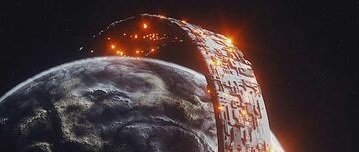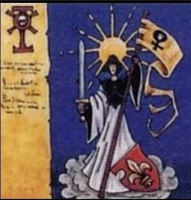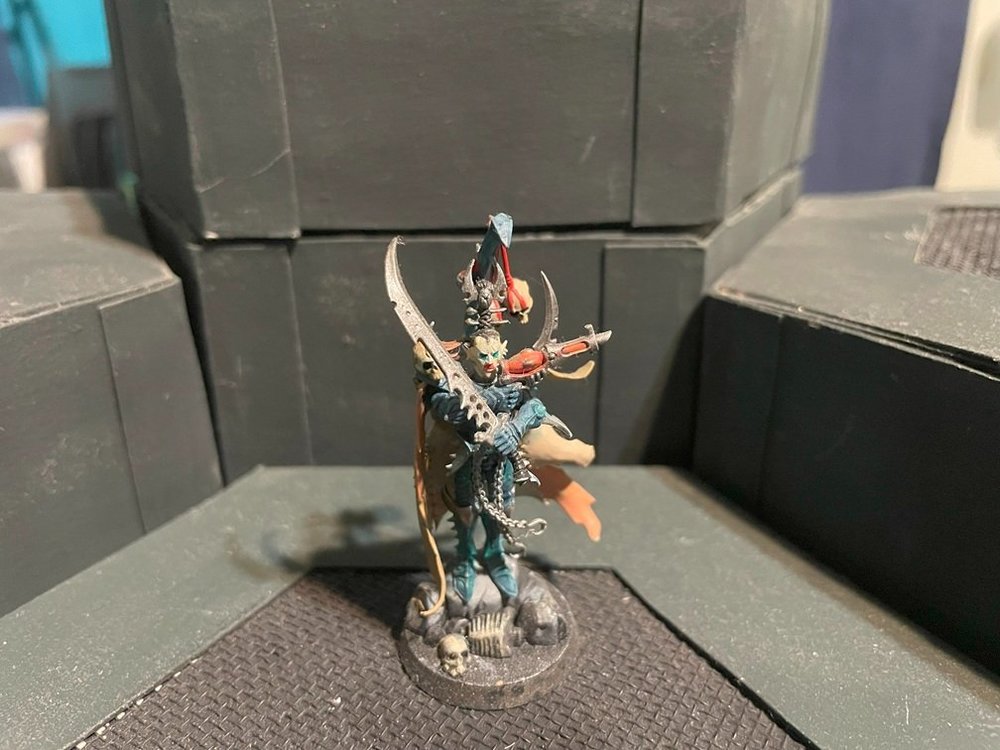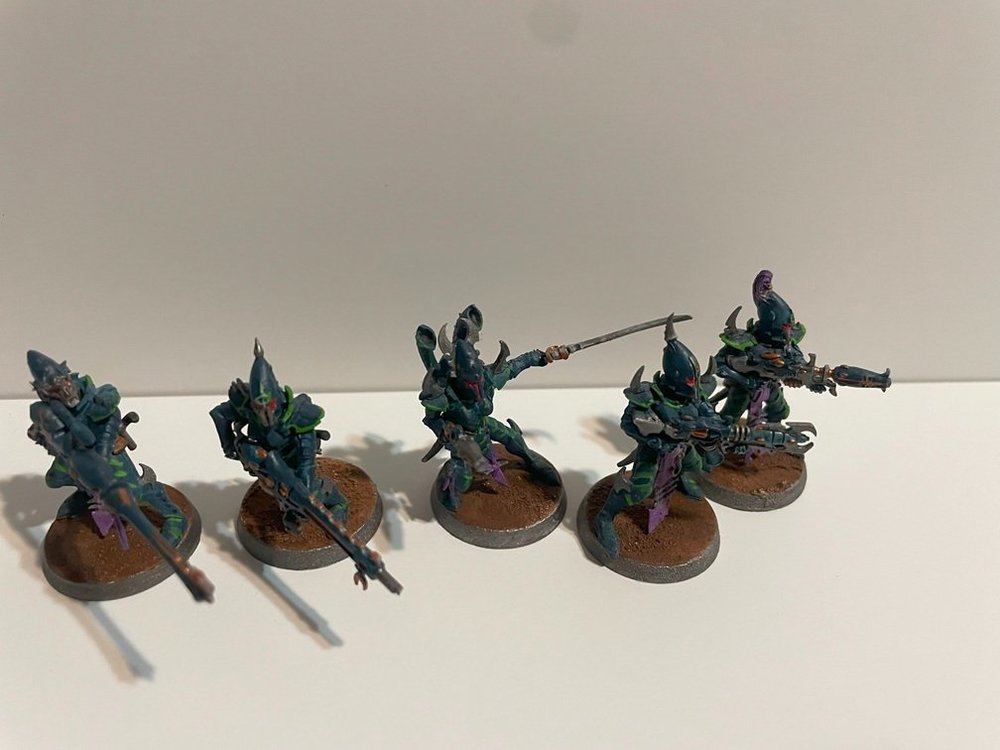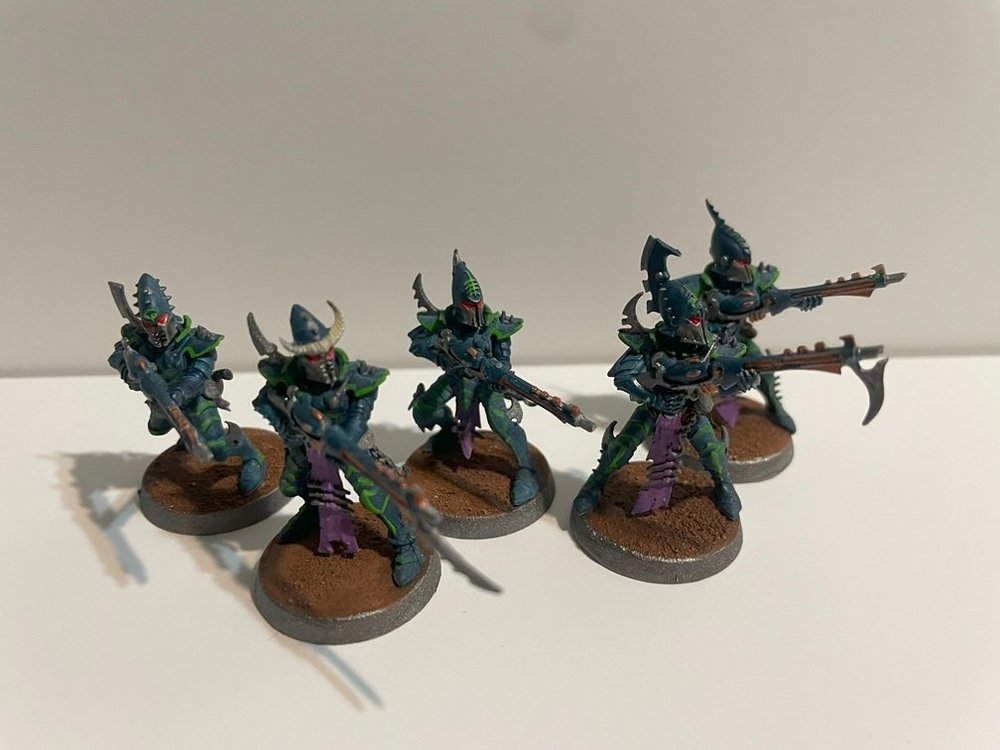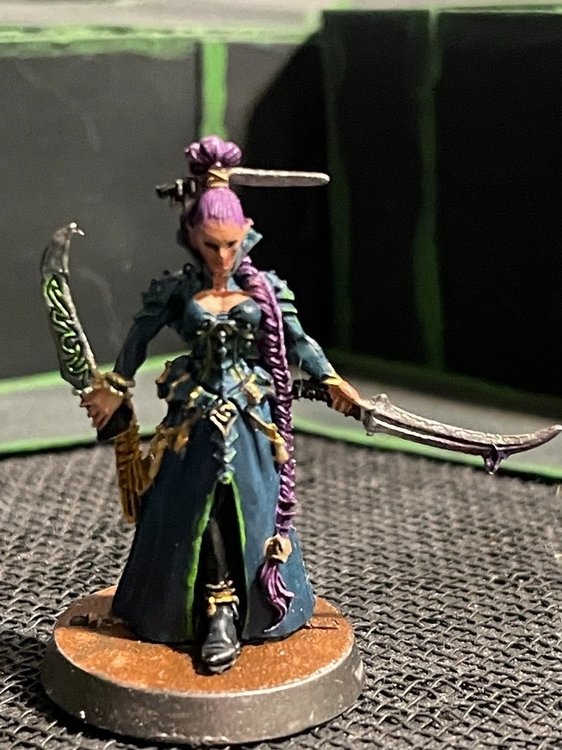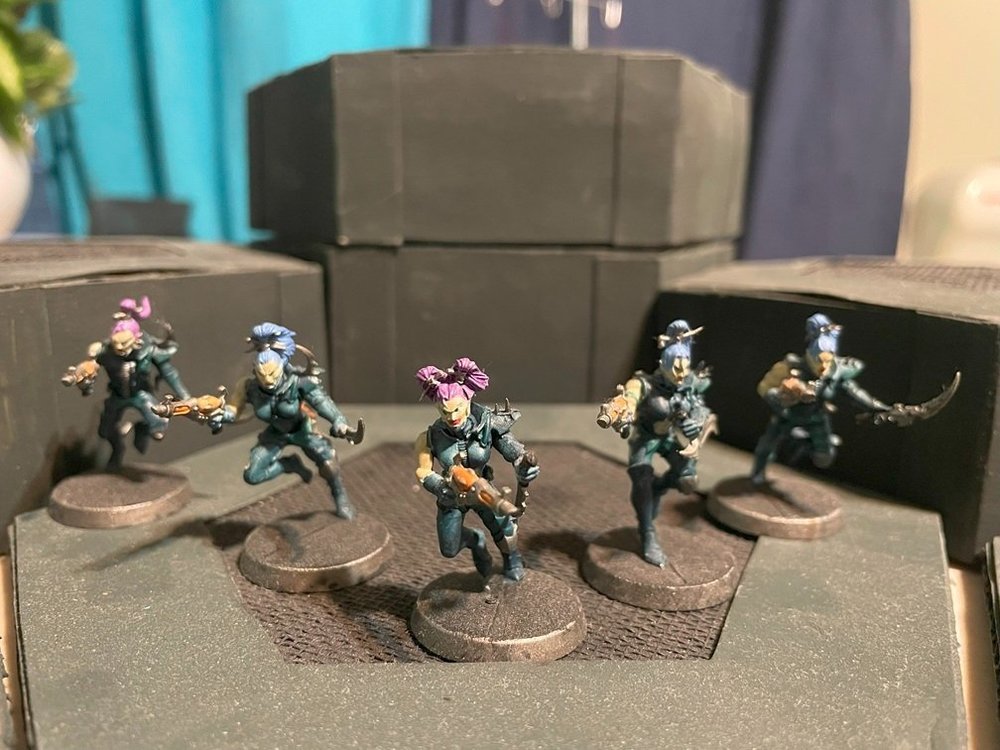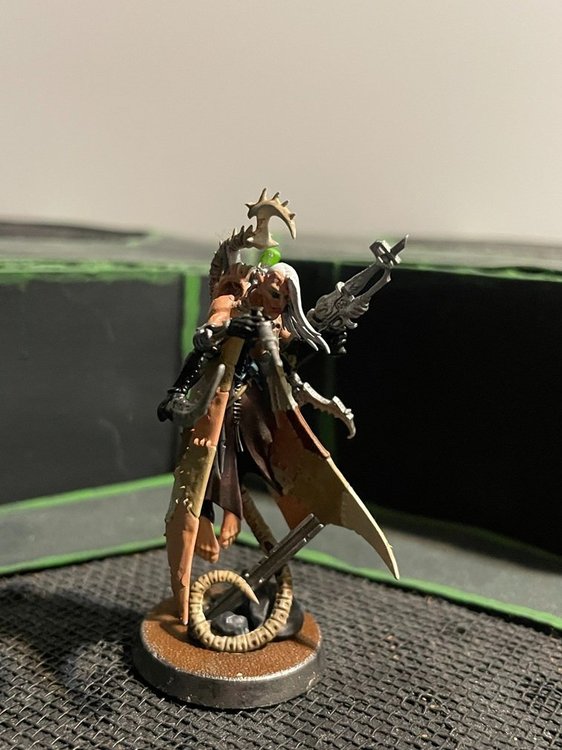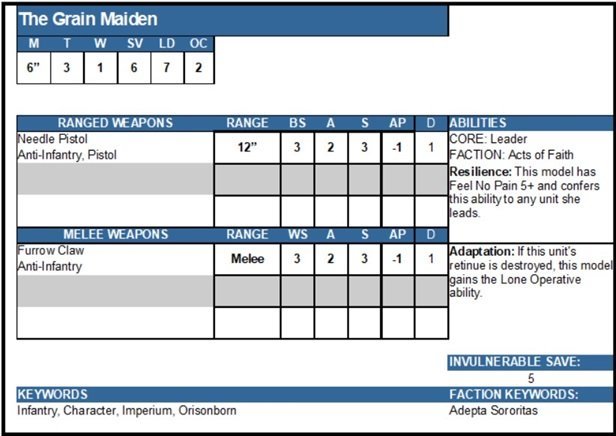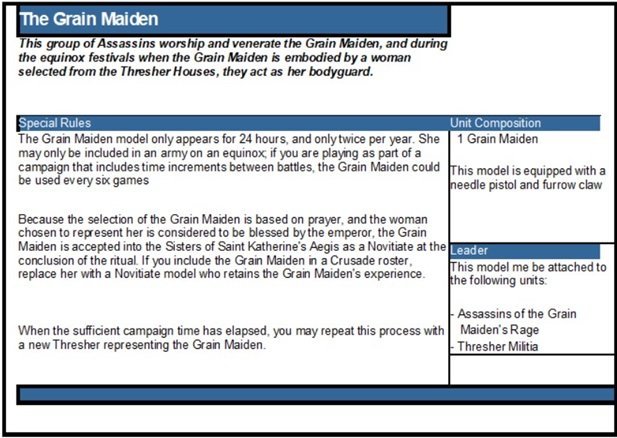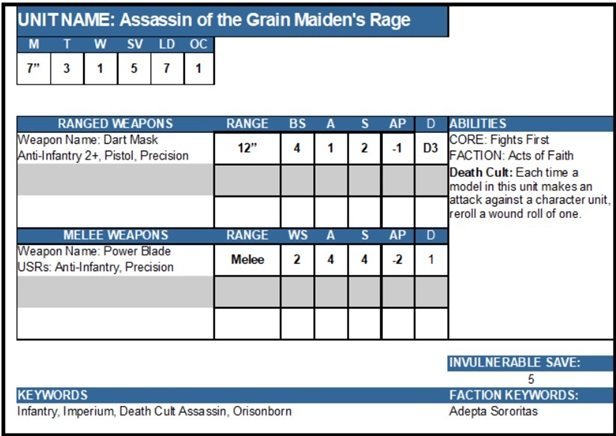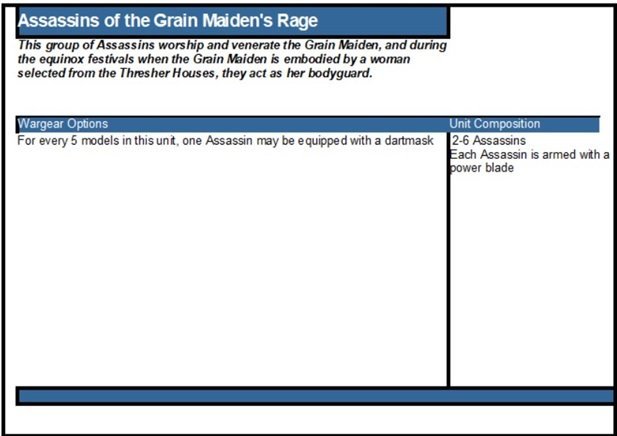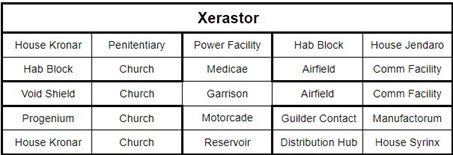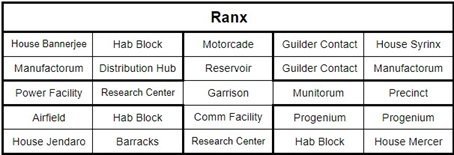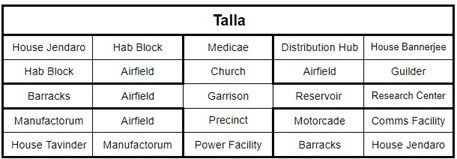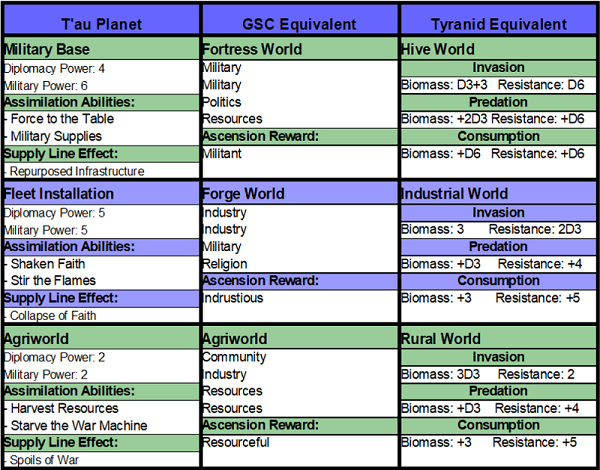Overview
About This Club
This club is a place for folks to post Crusade and Campaign related topics and discussions. If you are running a campaign, and you're looking to share rules or ask questions, this is the place. It's also a place to post updates about your own ongoing campaigns.
- What's new in this club
-
An Alliance with the Shattered Sky Pirates Before Draeven's Raid into the Fractured Spiral began in earnest, Xesh offered one more asset to the cause: a meeting with Felarch Varithander Xeres of the Shattered Sky Pirates, a fleet of Corsairs that she employs to sell her poisons beyond the boundaries of Commorragh. The Shattered Sky Pirates relat more closely to their dark kin than the Craftworlders, and they are infamous for their extensive use of Drukhari Aircraft. Draeven knows that air support could lend him an edge, both in Realspace Raids and the recovery of Docks territories in Commorragh. After extensive negotiations, the Corsairs agree to support Draeven's Crusade in exchange for his assistance with data retrieval from an ancient Space Hulk that has recently emerged in the Pacificus Sector. Xeres is willing to provide aircaft and infantry in exchange for any information regarding the movements of Aeldari Craftworlds, fleets... Or even individual voidcaft. In truth, Xeres is following rumours about a particular vessel: The Eye of Vect- an experimental stealth ship stolen from the Dark Muse himself by a notorious pirate known as Veth Rayden... But Xeres has deemed it safer to keep the true objective a secret from his Drukhari companions. Meta Notes: Back in June (2025), I was offered an opportunity to play in a Boarding Action League in my local store. I decided to take the plunge because I really needed to get playing. I decided to use my Drukhari army, hoping that playing them would motivate me to finish painting them so that I could finally start my Commorragh campaign. And it worked! All the models pictured above form my Space Lane Raider army (the Lhamaean is a proxy for the Succubus until I get around to fighting my Arena battle to determine what the REAL Succubus will look like). So far, I have fought three games- One in July, one in September and I just finished the third game tonight (October 7, 2025). For the first two games, my models were not fully painted, and in the first game, they weren't even fully assembled. I kept painting though, finishing my Kabalites, which I had pledged for 12 Months of Hobby in March (of 2023!), and then the Haemonculus, Wracks, Mandrakes and Court for Call to Arms 2025, which completed on time. Due to the poor paint jobs in those first two games, I didn't take great notes or photos. The games are also NOT actually Crusade games, though I have played Agendas that didn't interfere with the game play, and I did track the XP. Before I was able to post anything about those games here, I suffered a massive computer failure that wiped out the few records I did keep. I've been able to reconstruct the first two games- particularly the post-game progression, and the third game is still fresh in my memory. The First Encounter- Pain and Pestilence Draeven's Spacelane Raiders boarded the Hulk through a webway portal from a Shattered Sky scout vessel. It didn't take long to find a section of the massive amalgam of fused voidcraft with functioning power systems sufficient to support data archives. Both the Draeven Blades and the Faceless Sons secured an archive and began downloading any files that might be of use to the Shattered Sky. It soon became evident that the Drukhari were not alone. Foul Marines of Nurgle ambushed the Raiders as they spread out in search of additional archives. The Drukhari were able to inflict casualties upon several of Nurgles putrid minions, but found themselves incapable of eliminating full units. The Wyches, under the guidance of a Mercenary Succubus known as Derrida Apex, maintained their control over the archive, but the Deathguard prevented Draeven's Raiders from engaging any of the additional archives. The Raiders were forced to retreat, and Derrida Apex was killed in battle. All was not lost however: Vivithrax and the Bonewoven were able to harvest a chaos spawn, whose flesh they intend to shape into their first Talos, and the data that they were able to retrieve was valuable enough to the Shattered Sky that the Pirates have agreed to commit a single Razorwing Fighter to Draeven's army. Post-Game: The Army earned a Requisition point for the game, but failed to acquire any Raid Spoils. Each unit in the game received an experience point for playing, but with no Kill Points for anyone, NO ONE met the conditions to complete the Demonstrate Superiority Agenda. I marked the Wyches for greatness, as they earned the only Victory Points I was able to score by maintaining control of their objective for the entire game via the Secure Objective Maneuver. Finally, Derrida Apex was removed from the roster- I had only intended to use this character once: she was an unpainted Witch-Elf model used as a proxy until I fight the Arena Battle that will determine who the actual Succubus will be. So at the end of the battle, the army looks like this: Requisition Points: 1 Raid Spoils: 1 Supply Limit: 500 Points Sykil Draeven: 1XP Derrida Apex: Deceased Vivithithrax the Boneweaver: 1XP The Deathsight: 1XP Wyches: 4XP The Bonewoven: 1XP The Shadowthralls: 1XP I will post the results of battles two and three tomorrow; when I started this post, I though I could get it all done in one night, but it's midnight and I'm tired. Suffice it to say for now that Sykil's luck is about to turn, as the next two battles are victories with some pretty spectacular Agenda results.
-
The Ascension of Sykil Draeven, the Daemonslayer Sykil, the sixth Trueborn son of House Draven, was among thousands of spectators at the Crucibael on the night that Yvraine the Daughter of Shades challenged Lelith Hesperax to a duel that would change Commorragh forever. During that fated single combat, a shard of Ynnead's consciousness awakened within Yvraine, and a thousand shrieking Daemons of Slaanesh tore their way into Commorragh. In the chaos that followed, only the combat training he had received as an heir to his House allowed Draeven to escape the carnage. Upon his return to the Draevenspire, Sykil found that the incursion had outpaced him, and his famil's legacy was beseiged. The families of House Draeven set aside their intrigues and schemes to mount a coordinated defense and containment operation. Sykil took up arms with an elite team of special operatives known as the Enigma Killers. In the battles that followed, Sykil and the Enigma Killers would distinguish themselves in several critical battles to push the Daemons back. When the last abomination was crushed beneath their heels and the Draevenspire was reclaimed, Sykil was promoted to the rank of Archon. As the first trial of his esteemed rank, Draeven was given the task to assemble an army and reclaim the Fractured Spiral, a splinter realm belonging to one of house Draeven's closest allies, the Lord Haemonculus, Vypus the Pale. Dawn of the Splintered Enigma Three of Draeven's closest teammates, including two Trueborn warriors, left the Enigma Killers to join him. They named their nascent Kabal the Splintered Enigma, to honour the Enigma Killers who had brought them together and trained them. Draeven's companions recruited a team from across the Draevenspire to complete their unit. Known as the Deathsight, they serve as both Sykil's Hand, and the preeminent unit within his army. In addition to the three former members of the Enigma Killers, the team includes both weapon specialists and agents chosen for their knowledge of the Fractured Spiral, which will provide an opportunity for Draeven to capture key territories early in the campaign. The Deathsight From left to right: Aetheria Destra, Dark Lance (Heavy Gunner) Notes: The first of Draeven's Trueborn Enigma Killers, Destra is the preeminent weapons tech of the Deathsight. In addition to her intimate knowledge of Drukhari technology, she has also studied the tech of the various other slave races and horrors of the forty-first millennium. She has no intention to seek a greater leadership role within the growing Kabal. Rayna Mallifex, Splinter Cannon (Heavy Gunner) Notes: Rayna apprenticed under the Lhamaean, Skythia Vesh at a Toxin Distillery before joining the Deathsight, and her knowledge of poisoncraft rivals her skill with the Heavy Splinter Cannon. Well trained, Rayna lacks the battle experience of many of her companions, and has formed a particular bond with Destra, who trades the secrets of weapon tech in exchange for greater knowledge of poisoncraft. Evarra Myrillian, Sybarite: Blast Pistol, Power Sword, Phantasm Grenade Launcher Notes: Evarra is as skilled with melee weapons as ranged, and is a disciple of terror tactics and spycraft. She is Draeven's closest friend, and a Trueborn Enigma Killer who expects to one day grow the Deathsight into a full Splinter of Draeven's Kabal, which she would rule as an Archon in her own right. Laeryl Absynthia, Shredder (Gunner) Notes: Laeryl is the principle torturer of the Deathsight, having worked as a personal bodyguard to Vypus the Pale. She delights in the flensing of those deemed unworthy of slavery and delights in the trauma caused by the shredder she carries into combat. Lothos Saerrin, Blaster (Gunner) Notes: Draeven's final Enigma Killer, Lothos is a skilled pilot in addition to his role within the Deathsight. He has contracts among the Corsairs and has visited many of the landing facilities within the Fractured Spiral. He has detailed knowledge of the security protocols for these territories. Front: Kinael Darrow, Splinter Rifle with straight blade bayonet (Standard Operative) J'Kael Darrow, Splinter Rifle with drop blade bayonet (Standard Operative) Notes: J'Kael and his brother Kinael are interested in honing their close combat skills, and often occupy the forward positions when the Deathsight deploys in order to receive the brunt of those who would dare to charge the unit. Both have visited the Wych Cult Arenas of the Fractured Spiral, and they are enthusiast of both gladitorial arts and the accompanying combat drugs. Vyrtek Krael, Splinter Rifle (Standard Operative) Notes: Vyrtek distinguished himself battling the Daemonic hordes despite his relatively low status prior to the incursion. It is said that he possesses on unassailable will which insulates him against the siren song and soporific musk Slaaneshi Daemonkin. Ophidian Jarell, Splinter Rifle (Standard Operative) Notes: Ophidian is a tracker who worked as a bounty hunter prior to the Daemonic Incursion. He is comfortable navigating the slums, including those of the Fractured Spiral, and his familiarity with the terrain and the denizens of these territories are as much an asset to the Deathsight as his skill as a marksman. Janex Daeridian, Splinter Rifle (Standard Operative) Notes: Janex is a student of esoteric lore, and one who has risked proximity to Aelindrach to seek the counsel of Mandrakes and other denizens of the shadowrealm. He is known for his grim resolve at fraying of reality when the tide of chaos is at hand. Skythia Xesh With his Hand assembled, he began to seek support from the allies of his House. The first to volunteer her services was one of his family's most trusted retainers- a Lhamaean known as Skythia Xesh. Unlike many of her kind, who are content with serving in the retinue of a promising Archon, Xesh manages several poison distilleries among the familes of House Draeven, and she has built a network of spies and allies of her own. While she is careful to maintain direct control over these assets, she is willing to use them in the service of the Splintered Enigma, provided she is given exclusive domain over any of the Factured Spiral's Poison Distilleries as they are recovered. The Wych Cults With the aid of the Deathsight and Skythia Xesh, Draeven began planning his first raid into the Fractured Spiral. Their point of entry would be the celebrated arena Mesmoria. Skythia suggested that it would be wise to bring a team of Wyches, and offered up five of the Faceless Sons, a Cult that she had recruited into her personal guard. Draeven, in turn scoured the arenas of the Draevenspire for five Wyches of his own, with the intent of shaping them into a new Cult. The Faceless Sons The Wyches of Skythia's guard belong to an established Cult known as the Faceless Sons due to the prevalence of male gladiators. Three of the Wyches contributed to the raid are masked men- the Cult's namesake. Unlike other gladiators, the Faceless Sons are known by a singular name to distance themselves from House affiliations who may not approve of their commitments to the Arenas. From left to right: Irithax- A direct disciple of the founder of the Faceless Sons, for Irithrax, the success of his cult is a political agenda. He hopes to prove the Faceless Sons against the Dravaenblades to secure a place at his side in a Realspace Raid. He believes that reclaiming the Fractured Spiral will raise the the profile of not only the Faceless Sons, but all the men of the arena. Jadelyth Minyx- For Jadelyth, the Faceless Sons are means to an end. She recognizes that the Cult seeks to improve the profile of male Wyches, and while she believes there is an important role for men in the arenas, she also knows that in order to achieve their goals it will also always be necessary for the men of the Cult to outside their female counterparts. Shotokann- Shotokann is a proficient poisoner who learned his craft under the tutelage of Skythia Xesh. He sees himself as a successor to Yaelindra through Xesh's intercession, and is as fascinated by poison as the arena. Shalassa Viderran- Shalassa is Shotokann's sister, though this bond can never be acknowledged without revealing his family identity. She supports his efforts within the Cult, but also encourages his study of poisons as the path of the poisoner would allow him open access to the resources of House Viderran in a way that the Cult does not. Myrro- Myrro is heavily addicted to combat drugs, and he works closely with a circle of Elixicants who supply the Faceless Sons. He hopes to join the ranks of the Elixicants himself, and he intends to expand distribution as the Faceless Sons sworn to the Splinter Enigma continues to attract additional recruits. The Draevenblades While the Wyches gathered by Draeven are not yet a cult, they have trained together as the Draevenblades. Should they prove successful in the arena, they will become a Wych Cult in their own right, with a new name to be chosen when one amongst them attains the rank of Succubus. From left to right: Therogar Mirothex- Intrigued by the potential of the Faceless Sons, Therogar is loyal to his team but only to a point. He is the only male Wych on his team, and while he was prepared to walk in the shadows of his team mates, he does wonder if the Faceless Sons offer a better future. Myrae Lirieth- A student of arcane Lore, Myrae serves as a source of knowledge for her team mates. She joined Draeven's fledgling cult as much for the chance to explore the Fractured Spiral as to fight in the Arenas. She has been preparing most of her life to join a realspace raid, and is hopeful that Draeven will offer her an opportunity. Syndaera Thraxis- In addition to her considerable combat skills, Syndaera is also a strategist and leader with an interest in achieving the title of Succubus. She is grateful to Draeven for gathering the Wyches and providing this opportunity; she sees the Faceless Sons as an aberration, and hopes to defeat them in the arena to maintain the Matriarchy of Commorragh's Wych Cults. Kyriel Illanyr- Kyriel is Syndaera's closest ally- the two found each other after being expelled from their houses to fend for themselves among the nightmare city of Commorragh, and only that partnership has kept them alive. Kyriel would be more likely to support Syndaera's bid for leadership rather than launch her own. Janivyr Kadence- An Impaler and Shardnet specialist, Janivyr is a born duelist. She has no interest in leadership- only a consuming passion for weaponcraft; her expertise with arena weapons, even those outside her specialization is unmatched among her team mates. Vivithrax the Boneweaver Vivithrax was an apprentice to Vypus the Pale, and fought in the defense of the Fractured Spiral before it was captured by the Thirsting Minions of Slaanesh. He alone is aware of the Oubliette beneath Mesmoria's Alpha Floor. He hopes to be the puppet master behind Draeven, guiding his efforts to reclaim the Fractured Spiral for maximum personal advantage. The Bonewoven Rear, flanking Vivithrax: Karyx the Acothyst: Hexrifle Karyx is the only minion that survived the fall of the Fractured Spiral. It is fiercely loyal to its Master, and capable of both leadership and independence. It is obsessed with capturing additional specimens so that the Master may replace the forces lost to the fall. Syralex the Venomous, Stinger Pistol In addition to wielding the unit's Stinger Pistol, Syralex is a test subject for the poisons he employs. This prolonged exposure has created a poison tolerance greater than that of its peers. Front, left to right: Jarek the Bonesinger, Ossefactor As the operator of the unit's Ossefactor, Jarek is a direct apprentice to Vivithrax. It sees its arcane weapon as more of a tool, and it takes great care to craft only those extrusions of bone that best prolong the suffering of its victims. Malyketh the Inevitable, Wrack blades This one is known for its ability to maintain a withering hail of blows despite the most determined of defenses or counterattacks, wearing down its opponents until they are no longer capable of defending themselves Ophyrum the Emulsifier, Liquifier Gun It is Ophyrum's task to dispose of those enemies deemed insufficient for reclamation by the Master. Other more suitable specimens are left to its companions. Of all of the Bonewoven, this one is the most committed to the utter destruction of its foes. The Shadowthralls of Netherweir These Mandrakes are young, and have not yet carved identities and roles for themselves, and as such have not earned names. If the group has a leader at all, it is the Thrall who carries the sickle. These Thralls have been sent to Mesmoria to learn about those who seek to reclaim the Fractured Spiral, as they may be useful in the conquest and expansion of the other Shadow Districts.
-
kabaakaba joined the club
-
I think that I'm going to grab the Deathwatch vs. Necrons box, and maybe a couple of Necron units to go with it to form a Boarding Action army. But I was wondering, have you played in of the Necron Teams in Kill Team? And specifically 9th edition: the spec-ops rules from 9th ed, I found, helped as springboard rules for Crusade- specifically, those Home-base upgrade Assets. I found these really helped me visualize what a small base for the faction would look like. The backgroun pages are also helpful with their name generators and unit quirks. This kind of information, for me, has always provided more reliable details about how the faction operates than all of the "fluff" text or BL novels, many of which unrealistically distort the way the faction actually plays in game. The trouble as, they killed Spec-ops in KT24, and I never had any of the 9th ed Necron teams, so I have no glorious Necron Spec-ops to read. If you DO have accress to the conent, I was wondering if you'd mind posting even just what the Home-base upgrade Assets were with a super brief one liner of the associate rule, it would give me a starting point. Also, the titles of the books that those rules came from might allow me to look for downloads or cheap Ebay copies... Normally I like to respect copyright, but once materials are no longer commercially available, that ceases to be an option. Cheers!
-
Yesss...as of the Nachmund Gauntlet Crusade Campaign, even named Epic Characters have upgrades nowadays, but thanks for checking in! You're our resident Crusade expert on B&C. This change from previously is significant because you have things like...y'know...C'TAN that can get further upgrades. Upgrades can be force multipliers, so when you have something like upgrades on a C'tan, which I totally took advantage of with the Transcendant C'tan, you're multiplying a star god. Man, did I pick a winning horse with Necrons this edition. 9th was supposed to be their time in the sun, but it's like the sun never set. I do think it's because they're a natural foil to both the Imperium and the Traitor Legions, so they're like Always Relevant. I don't even like them that much personally. Just fast to paint.
-
Toe Bee joined the club
-
As part of my effort to post in this Club more often, I wanted to follow up on this post, even after so long. I never finished the Iron Challenge: it was one in a series of incomplete challenges, and while I was disappointed that I didn't finish, there IS more material for the project than I've posted here: I had an Iron Challenge Progress thread, and I posted the other stuff there. For the benefit of the Crusaders in this club (if you're interested), here are the datacards for two units I created for the challenge: The Grain Maiden and the Assassins of the Grain Maiden's Rage (GMR). So a few things here: first, you'll notice that a lot of the rules on the Grain Maiden card are very narrative focused, and many interact with how this unit integrates with the Crusade Roster: any Thresher woman can be the Grain Maiden, but only for a limited time, and only ever once: when the Equinox festival ends, she becomes a Novitiate. Six games later, another Thresher woman will be chosen as the new embodiment of the Grain Maiden, and when her ceremony ends, she too will become a Novitiate. Now, I think it's worth noting that while ALL of this stuff was in my head as background material, I never actually planned on creating house rules for any of it; I prefer to keep my house rules related to the campaign mechanics rather than the game mechanics, because I want to avoid even the perception of creating rules for the sake of power. That's why I tried to use only existing rules for my Harvester of Sorrow detachment (and yes, that is a deliberate Metallica reference- pre-Bob-Rockification, because METAL). Now while I ever proceed with the remaining elements of the Iron Challenge, despite deadlines long since passed? Yes. But I want to use the special rules sparingly. The names, background and fluff? That's Canon now- it's permanent, and it will be a part of every development within the sisters faction in this campaign... But the Fiery Heart/ Harvester of Sorrow rules come with a built-in sunset clause: eventually, the Desdaemona system will be rediscovered by the Imperium at large, and when that happens, the Sisters of Saint Katherine's Aegis will become another Mission of the Order of Our Martyred Lady. The grain Maiden and the Assassins of her Rage don't have a sunset clause, but there are built in limitations on their use. Originally, the Grain Maiden was going to be represented by a House Escher Death Maiden model, and I may follow through and stick to my guns on that, but there are also suitable models in the Sanctifiers box, and I might end up preferring to use one of those. Similarly, I had picked a Redemptionist model to represent a priest, because I wanted something plastic and neither Taddeus nor Pious fit... Both of them are going to appear in the campaign for a brief time AS the actual BSF characters, so I don't actually want to use those models to represent generic units. And that's it for now. My next planned post to this thread will be the painted models I pledged for the challenge... But that's going to take a while because I'm hip-deep in Drukhari right now, and there's a thread about them on the way, as well as a battle report that's three years in the making. In the meantime, however, I do welcome any feedback or conversation. Cheers!
-
W.A.Rorie joined the club
-
So first off, let me say I'm so sorry it's taken nine months to reply. But this is probably an even more relevant discussion now than it was originally posted, because as I understand it, the more recent campaign books HAVE allowed Epic characters to be included and to receive Crusade upgrades. As I understand it, they don't get a full four battle honours like generic units do, but the one or two upgrade powers that they do qualify for are pretty powerful, and their effects tend to extend beyond the character in question. I'm not sure how I feel about it; I like that generic characters become as well developed as named characters over the course of a campaign, and I think including options for Epic Character Crusade upgrades just undermines that, creating a pinnacle within the progression system which will forever remain unavailable to any of YOUR DUDES and only ever apply to GW's own characters. Having said that though, I know very little about Necrons, and I don't have any of the campaign books except the original Tyrannic War book. I do look forward to learning more about Necrons; with the upcoming Tombworld Terrain, Necron Kill Team and the KT box with the new plastic Nightbringer, I think it's time.
-
Hey there folks, I wanted to thank everyone who has checked out this club, followed or posted, and apologize that I haven't checked in as often as I should. It bummed me out to see that people's posts had gone ignored. I've reset my notifications so that the only time I get notified is direct messages and club posts, so now hopefully I'm more likely to catch things. I've reported in other places that I actually played my first game of 10th not long ago, and I finished a unit of Kabalites that were pledged for a 12 Month challenge in March of 2023! I've put a lot of work into my Wych Cult Arena and the fighting surface is ready... But I've been doing some design work for the spectator seating. Finally, I've pledged 5 Mandrakes, 5 Wracks, a Haemonculus and a Court of the Archon for this years Call to Arms. I'm expecting to finish both the Arena and the pledge by the end of my vacation on August 24. I actually want to finish all of that by mid-week next week, because I want to begin a Commorragh Crusade that will eventually connect back to Orison's Wake. Finally, I'm looking at expanding upon what I've posted about Imperial Citizens in the context of a new project: Index Necromunda. The Thresher Houses of Orison's Wake were always intended to be represented by Necromunda models, so in a sense, 40k Datacards for Necromunda Gangs and Thresher houses would be essentially the same thing. So, more information about all of this stuff IS on the way, though it won't be showing up here in general discussion- I think I'm going to put the Commorragh-based campaign content in the same place as as the rest of the Saint Katherine's Aegis campaign material rather than giving it a subforum of its own; if I did that, every campaign faction would end up with its own forum, and that really tears into sub-forum real estate. But I had to get the uncomfortable "Sorry to be an abstentee land-lord" post out of the way in order to move forward.
-
Decimus III joined the club
-
Hi guys, we're ramping up to a Pariah Nexus campaign in my local Warhammer Store. I'll be representing Necrons. My question: can Transcendant C'tan get Crusade upgrades now, like Tank/Monster Hunter or Weapon Buffs? I ask because of a few things I THINK still hold true: Epic Characters, like Nightbringer C'tan, cannot get Crusade upgrades (Aug 2025 edit - changed since Nachmund Gauntlet) The Transcendant C'tan is NOT named, but is also prevented from getting Enhancements And I think last edition and/or a Balance Dataslate, things went back and forth on the Trans C'tan a bit So I'm just checking up on the state of the rules right now, if Trans C'tan can get Crusade upgrades, as it's always in flux. Thanks.
-
N1SB joined the club
-
apologist joined the club
-
Hey folks, if you're here, thanks for checking it out. This club has been active for quite a while under the name Chronicles of Saint Katherine's Aegis, which is a monumental Crusade campaign that I've been slowly working on for a very, very long time. But it was kind of a lonely place, because I sorta framed as being all about me, when really, what I was hoping to do was start a place for folks who are Campaigners and Crusaders. This club also contains a rules development forum, but to be clear, the rules here should be mostly rules related to campaign play- whether Crusade, Spec-Ops, or just narrative campaigning. This is because B&C already has forums that may be more suitable to game rules, like homebrew stratagems, or other core mechanics. Finally, for those of you who are interested, content for the Chronicles of Saint Katherine's Aegis (CoSKA or SKA) is here as well. If you'd like to create a thread here for your own campaign, that would also be welcome edition to the club. I find that a lot of the rules I created for SKA could be used by other campaigners- so I post those as generic bits in the Rules Development forum and then apply and playtest them in the CoSKA section. If you would like to do something similar, we'd be happy to have you. So, how do you campaign? Do you used the Crusade books in 10th? Do you incorporate Kill Team? Do you like map-based play, escalation? Or would you like to explore more information about these various ways to play the game?
-
There are two large continents on Orison's Wake, in addition to a handful of islands that are too small to support agriculture. The larger continent, Farrow, supports the planet's capital city as well as four smaller STC settlements. The smaller continent, Lodi, supports four STC settlements, but lacks a larger city. Each settlement consists of 25 territories arranged in a 5 x 5 array. The center row and column are reserved for territories under Imperial control. each settlement has an Imperial Guard Garrison at the center of it's territory, and the settlement's reservoir and power facility will also always be located in Imperial Territory. Remain territories in the Imperial Zone are generated randomly from the Imperial Territory Table. This arrangement leaves four corner areas consisting of four territories each. These are each controlled by a random Thresher House; the outside corner of the map will contain the corresponding Thresher House territory. This is a special Hab Block where every resident is a member of one of the noble Thresher Houses. The remaining three territories in each corner area of the map are randomly generated from the territory table of their controlling house. The Settlements of Lodi: The Settlements of Farrow
-
Order Datafile: The Sisters of Saint Katherine’s Aegis Order Identification: Order of the Fiery Heart Organisational Structure: Mission Location: Segmentum Pacificus, Desdaemona System, Orison’s Wake Mission Commander: Cannoness Ailia Lavalle Primary Fortifications: The Chapel of Saint Katherine’s Aegis, Aegis City The Chapel of the Grain Maiden’s Prayer, Xerastor Order History: Discovery of the Desdaemona System The Desdaemona system lies on the Western fringe of Segmentum Pacificus. In the years following the Heresy, an Explorator Fleet of the Adeptus Mechanicus discovered a stable warp corridor at the edge of known space- a corridor which had an exit point beyond the boundaries of the Imperium into a star system of three habitable planets, rich with untapped resources. The Mechanicus established a relay station to mark the warp route, and over two Millennia, the Imperium began colonisation of the system. This began with the largest of the system’s three habitable planets- Desdaemona Prime. During the first wave of colonisation, the resources of this planet alone were sufficient to maintain the population, but over time, it was determined that the political centre of the system should be located off-world on the smaller and more defensible planet Miranda Regent. Desdaemona Prime grew to a great Hive world, exporting citizens across the system to extract resources from less habitable planetoids, to build orbital infrastructure and defences and finally to tithe and trade with the monolithic Imperium. Orison’s Wake, the final habitable world in-system, was colonised and designated as an agriworld to feed both the constant growth of Desdaemona Prime and the political elites of Miranda Regent. The Age of Apostasy At the peak of the Reign of Blood, the tyrant Goge Vandire sent vast fleets of Frateris Templar on unholy crusades of conquest and slaughter. One such fleet, destined for the naval base at Hydraphur, was sent lightyears rimward in the Empyrean turmoil common to the era. When the fleet emerged from the phenomenon, they were close enough to detect the Mechanicus beacon that marked the Desdaemona warp corridor. Reconnaissance vessels emerged and quickly cut off the isolated outpost of Echo Station, extracting intel from the captured traders to assist Vandire’s Frateris Templar fleet with the conquest and subjugation of the Desdaemona system. Once the full battery of the Heretic fleet arrived, the battle was quick and decisive. Vandire’s forces destroyed Military assets that were too distant or isolated to be centrally controlled and captured the rest. Over the decades of Vandire’s rule, the Desdaemona system was twisted to a shadow of its former self- at Desdaemona Prime, those who refused to submit to the depravity of their captors were burned by the thousands; Miranda Regent’s palaces and mansions were occupied by the senior officers of the fleet and the most brutal of the warlords who commanded the ground forces. The agricultural rites of sparsely populated Orison’s Wake were twisted into perverse fertility rituals, contaminating the food supply for the entire system with the taint of chaos. When Alicia Dominica finally took Vandire’s head, the reformation efforts spread outward from Terra along the most stable warp routes. But even along those corridors, systems were claimed based on the value of their assets, leaving the far edge of Pacificus to the continued depredations of chaos for solar decades after Vandire's defeat. The Desdaemona System continued to suffer until fate brought the Crusade fleet of Saint Katherine’s Fiery Heart to Hydraphur. As Katherine’s flagship approached the naval base, she was afflicted with visions of the suffering of Desdaemona’s faithful. Katherine attempted to follow through with her responsibilities to reinforce the fleet at Hydrafur, but the visions persisted, and in the end she put her trust in the wisdom of the Emperor, taking her flagship and a handful of escort ships west to the Mechincus relay station and ultimately, the Desdaemona system beyond. Vandire’s forces had become complacent after breaking the system, and they did not anticipate Katherine’s holy wrath. The system was reclaimed in less than a solar year. As Katherine’s fleet launched surprise raids against docking facilities, orbital defences and vital ground fortifications, loyal Imperial citizens of Desdaemona Prime found the courage to unpack hidden weapon caches, maintained from the early days of the Chaos invasion in support of their liberators. On Orison’s Wake, a Thresher woman known only as the Grain Maiden united the Thresher Houses to overthrow the shadowy advisors who had encouraged the corruption of ancient rituals. The Reconstruction Following the liberation, Saint Katherine continued her involvement with the Desdaemona System to ensure an effective reconstruction. First, she restored any of the elites who had escaped the purge of Miranda Regent to oversee the appointment of a new governor and the restoration of the Imperial tithe. Katherine assembled the rebel militias of Desdaemona Prime into the First regiment of Desdaemonian Primals with additional resources from the Imperium. At Orison’s Wake, she oversaw the construction and consecration of the Chapel of Saint Katherine’s Aegis; she established a Commandery of the Fiery Heart to defend it, and she had the Grain Maiden sanctified as an Imperial Saint for her role in the purification of the system’s food supply. She oversaw the repair and augmentation of orbital facilities around Miranda Regent into a dynamic ring of docks, hangars and weapon platforms known as Sycorax Delta. Finally, she oversaw the assembly of the Consecration Crusade fleet, which included ships from her own fleet. Katherine’s involvement in the restoration, however, was on borrowed time. The Reign of Blood was over, but the Plague of Unbelief was about to begin, and Katherine was needed at Hydrafur on a more permanent basis. Cardinal Bucharis had begun to push out from Gathalamor, and the fleet was on high alert. When Katherine finally emerged at the relay station, a large Heretic Fleet was detected at the outer limit of long range sensors. Knowing that she was out-gunned, and that the Desdaemona system would be vulnerable, Katherine made a critical decision. After a hasty evacuation, she detonated the relay station to conceal the passage to the Desdaemona System, and baited the Heretic Fleet back to Hydraphur where Imperial Reinforcements were able to outflank and cut off the enemy’s line of retreat, crushing them in a brutal pincer attack. Katherine had always intended to return and re-establish contact with the Desdaemona system, but the Plague of Unbelief turned out to be a larger threat than anyone had anticipated. The fleet that Katherine defeated at Hydrafur was only the first of many, and the Fiery Heart was deployed in ground invasions across the sector and beyond. Katherine herself was martyred at the hands of the Witch Cult of Mnestteus before she could complete the pilgrimage, leaving the Desdaemona system isolated for five Solar Millennia. The Stillness Desdaemonians refer to the era following Katherine’s departure as the Stillness. For a century or more, the citizens maintained hope that Katherine would return to reestablish a connection with the larger Imperium. In time, however, that hope faded. While Katherine continued to be regarded as a liberator, living memory of her faded, and the Chapel of Saint Katherine’s Aegis attracted fewer and fewer pilgrims from the other inhabited planets in the system. Without new recruits from the Convents at Terra and Ophelia VII, it was determined that many of the resources deployed at Orison’s Wake would be better used on Desdaemona Prime, where they could recruit and train new Sisters from the larger population. As the Sisters of Saint Katherine’s Aegis saw their forces redeployed, they were promised that in time, recruits from Desdaemona Prime would be sent back to replace the losses. Instead, many of the recruiting Missions on the larger planet consolidated to form a Commandery of their own, while the Sisters of Saint Katherine’s Aegis saw their once proud Commandery reduced to a mere Mission- a shadow of the force once celebrated and blessed by Katherine herself. In time, Sisters of the Aegis began to distrust the Commandery at Desdaemona Prime. What was sent from Desdaemona Prime instead of the requested sisters were the 17th, 25th and 33rd Companies of Desdaemonian Primals, as well as Precinct 13 of the Adeptus Arbites, placing local authority in the hands of other Imperial forces and further diminishing the role the Sisters of Saint Katherine’s Aegis had once played in maintaining order. Over time, the Sisters were left with no choice but to work with their Thresher allies in House Kronar to establish Schola Progenium territories in the settlements to plant the seeds for local recruitment. In addition to recruiting from the children of the Imperial forces stationed at Orison’s Wake, these facilities now recruit the most promising children of the Thresher Houses. The Sisters of Saint Katherine’s Aegis Due to their long separation from the Imperium, the Sisters of Saint Katherine’s Aegis retain their ancient connection to the Order of the Fiery Heart- they never experienced the Martyrdom of their Matron Saint, avoiding the grief that transformed their coreward sisters into the Order of Our Martyred Lady. In the Desdaemona system, there is no cult of martyrdom within the sisterhood; Katherine is remembered as an impetuous, living warrior saint. On the battlefield, their strategy and technique is closer to the Daughters of the Emperor than the Adepta Sororitas- they strive to incorporate the holy trinity of bolter, meltagun and flamer into as many of their units as possible. While the Commandery at Desdaemona Prime and the Mission at Orison’s Wake belong to the same Order, the Orisonborn see themselves as separate from their Desdaemonian Sisters. They work closely with the Thresher militia of House Kronar and the Death Cult known as the Grain Maiden’s Rage. These allies are particularly powerful during the equinox festivals associated with the planting and harvesting seasons, when the Death Cultists are occasionally accompanied by a living embodiment of the Grain Maiden herself. The Orisonborn always treat their Sisters of the Fiery Heart with respect, but they are accustomed to conducting themselves without input or interference from the Commandery. In recent years, however, this has led to tension within the Mission after Palatine Ailia Lavalle was sent to Orison’s Wake with a bodyguard of Sacressants and a unit of Seraphim to reinforce the Mission. The Sister of Saint Katherine's Aegis welcomed the reinforcements, but they fear that the Commandery will see this as an opportunity to exert their authority over the Mission at Orison's Wake. Mission Assets and the Distribution of Forces The landmass of Orison’s Wake consists of two large continents and a few scattered islands too small to support agriculture. The larger continent, Farrow, is home to the planetary capital, Aegis City, named for the Chapel of Saint Katherine’s Aegis, which lies at the heart of the city. In addition to the capital, Farrow boasts four settlements. The Mission has a secondary shrine in the settlement of Thraxa, which is maintained with the support of the Threshers of House Kronar. Finally, a tertiary shrine in the settlement of Talla supports an Imperial Medicae facility. The Mission has no assets in the remaining settlements, Krannick and Varga. Palatine Ailia Lavalle was recently sent to the Chapel of Saint Katherine’s Aegis by the Fiery Heart Commandery, along with a Sacressant Bodyguard and a unit of Seraphim. Lavalle would serve under Canoness Jalissa Kronar, a weathered and wizened Orisonborn, known to her Sisters and congregants as the Reverend Mother. Lavalle would earn the respect of her new sisters in a vicious campaign against Drukhari raiders in the continental northwest on the far side of Thraxa. The victory, however, was bittersweet; during the final battle, the Reverend Mother was infected with a virulent poison, and while she was able to walk unassisted from the battle, she succumbed to the infection three days later. It was assumed that Orisonborn Palatine Lauriel Syrinx would be promoted to Canoness and that Sister Lavalle would assume her position as the senior Sister stationed on the smaller continent of Lodi. Instead, the Commandery at Desdaemona Prime promoted Lavalle and installed her as the Canoness of Saint Katherine’s Aegis. While Ailia had proven her worth in battle and none would ever question her loyalty to the Emperor or the Sisterhood, there were many who felt that the position of Canoness was better suited to an Orisonborn daughter of the Grain Maiden’s blessing. The Sisters stationed on Lodi are all native daughters of Orison’s Wake. The Chapel of the Grain Maiden’s Prayer, located in the settlement of Xerastor, rivals the size of its sister chapel in Aegis City, but much of it sits upon land owned by the Threshers of House Kronar. It supports and is in turn supported by a Progenium Facility as well as a Penitentiary. The settlement of Miro is home to a secondary shrine, maintained by a Preacher and a unit of Arcoflagellants. The Sisterhood has no assets in the remaining territories, Theryll and Ranx. Optional Rules The following optional rules can be used to represent the Sisters of Saint Katherine’s Aegis, who differ significantly from the Order of Our Martyred Lady, and are not well suited to detachment rules that privilege martyrdom. The Harvester of Sorrow detachment uses some 9th Edition rules to better approximate the Fiery Heart battle tactics employed by both the Sisters of Saint Katherine's Aegis and the Commandery at Desdaemona Prime. When the storyline of this Crusade brings the Desdaemona System back int contact with the larger Imperium, both the Sisters of Saint Katherine's Aegis and the Fiery Heart Commandery will be reeducated and join the Order of Our Martyred Lady. In addition to the Harvester of Sorrow Detachment, these rules include four new datasheets: the Grain Maiden, the Assassins of the Grain Maiden's Rage, Thresher Militia and Thresher Command. These units represent forces drawn from the Threshers of House Kronar, strong allies to the Sisters of Saint Katherine's Aegis since the day Katherine elevated the Grain Maiden to Sainthood. They will only serve under Sisters who are native to Orison's Wake. This is represented by the Orisonborn Keyword. Not all Sisters of Saint Katherine's Aegis are Orisonborn- Canoness Ailia Lavalle, her Sacressants and her Seraphim have all been sent by the Fiery Heart Commandery at Desdaemona Prime, with a high probablitlity of additional reinforcements. Additional Orisonborn, however, can only join the Sisters of Katherine's Aegis in the four units presented here, or as Novitiates- graduates from Progenium facilities which are often located on Kronar controlled territories. Detachment Rule: Harvester of Sorrow Saint Katherine instilled in her Order of the Fiery Heart a reverence for the Holy Trinity of Bolter, Flamer and Melta. The Sisters of Saint Katherines Aegis see the heat beams of the melta as the scythes which reap the harvest. Each time a unit with this ability makes an attack with a melta weapon, the target of that attack is considered to be in half range for the purposes of that weapon’s abilities if: The weapon has the pistol or assault trait The weapon has the Heavy trait and the target is with 18” of the firing model Strategems: Cleansed by Fire (2 CP) Harvester of Sorrow- Battle Tactic Strategem When: Your shooting phase. Target: One Adepta Sororitas unit that has been selected to make a shooting attack. Effect: When that unit makes an attack, do not roll to determine the number of attacks; instead, that weapon automatically make the maximum number of attacks. A Moment of Grace (1 CP) Harvester of Sorrow- Epic Deed Strategem When: Any phase. Target: One Adepta Sororitas unit that has just made a hit, wound or save roll. Effect: The unit may discard one or two Miracle Dice: add +1 to that roll for each Miracle Dice discarded. Faith and Fury (1 CP) Harvester of Sorrow- Strategic Ploy Strategem When: Shooting phase or fight phase. Target: One Adepta Sororitas unit that has just used an Act of Faith for a shooting or melee attack. Effect: That unit may immediately use that Miracle Dice for the wound roll. This does not count as an additional Act of Faith. Judgement of the Faithful (1 CP) Harvester of Sorrow- Strategic Ploy Strategem When: Movement Phase. Target: One Adepta Sororitas unit that has made a fallback move. Effect: That unit may make a shooting attack even though it made a fallback move. Holy Trinity (1 CP) Harvester of Sorrow- Wargear Strategem When: Your shooting phase. Target: One Adeptus Sororitas unit that has been selected to make a shooting attack. Effect: The attacking unit can only target one enemy unit that is visible to and within range of at least one of the attacking unit’s bolt weapons, melta weapons and flame weapons; each hit with these weapons receives +1 to wound. Daughters of the Aegis (1 CP) Harvester of Sorrow- Strategic Ploy Strategem When: Enemy shooting or fight phase. Target: One Adepta Sororitas unit that has been chosen as the target of a shooting or melee attack. Effect: Until the end of the phase, each time this unit is hit by an attack with AP 1, that attack is considered to be AP 0. Enhancements: The Grainmaiden’s Resolve During the uprising against Vandire’s forces, a Thresher woman known only as the Grain Maiden rose up to lead the Threshers against the forces that had corrupted their agricultural rituals. It was said that with her intimate knowledge of the land, the Grain Maiden could appear anywhere. Orisonborn Adepta Sororitas character model only. This model and any Assassins of the Grain Maiden’s Rage or Thresher unit that she is attached to gain the infiltrate ability. If this model’s retinue is destroyed, the model gains the lone operative ability. Note: this enhancement can not be used in games which include a Host of the Grain Maiden model. The Warscythe of Orison’s Wake This sacred weapon was used by the Grain Maiden in the final battle with the sorcerous cabal responsible for the subversion of the agricultural rituals of the Thresher Houses. Orisonborn Adepta Sororitas character model only. The bearer of this weapon may make 5 AP-3 D-2 attacks; if this unit attacks during a turn in which it charged, this weapon inflicts an additional mortal wound. This weapon may not be used during a turn in which the bearer attacked with another weapon. Saint Katherine’s Aegis While the Praesidium Protectiva carried to battle in the Triumph of Saint Katherine is a true Praesidium, it is not the shield that Katherine carried into battle on behalf of Alicia Dominica. Prior to her departure from the Desdaemona system, Katherine hid the true Aegis beneath the Chapel that bears its name, where it has remained for five thousand years. Upon her return to Hydrafur to face the fleet of Cardinal Bucharis, Katherine adopted the Praesidium that currently travels with the Triumph. Adepta Sororitas model only. This shield confers a 4+ Invulnerable save to the bearer’s unit. If every model in the bearer’s unit has the Orisonborn keyword, that unit is additionally assumed to automatically pass any battleshock test it is required to make. Condemnor of the Hereticus This mastercrafted condemnor boltgun is granted to the Sister who serves in the capacity of Inquisitorial Liaison. In addition to its martial functions, this weapon serves as a badge of honour, and it is a reminder that the Eye of the Emperor is always watching. Adepta Sororitas model equipped with a Condemnor Boltgun. That weapons type is changed to assault, and the weapon receives +1 Attack, +1 Strength, + 2 AP, and +1 Damage.
-
I don't know how much the idea of Imperial citizens as models appeals to the broad playerbase- the conversation comes up now and again on forums: people need citizen models for dioramas, or objective markers, etc. For me, this kind of world building has always been a part of GW's appeal. I remember looking at Dark Future models in White Dwarf and thinking about using them to expand what I could represent on a table. I remember some of the Forgeworld non-combat support units and feeling the same way. As a final source of inspiration, I cite the Citadel Journal's Covert X campaign and their Urban Infiltration rules, where you could buy stands of Imperial Citizens to place on the board, which would move randomly (via control rolls every turn to determine which player could move them). The schtick was that the Infiltrator Units of Covert X, if left in reserve, could subsequently choose to emerge from any stand of citizens on the board. So if someone wanted to take it further, what would Imperial citizens look like, what might their functions be, and how would you shape and define them into distinctive groups? Necromunda does some of the heavy lifting for me- distinctions between underhivers, gangs, and spyrers, plus the dramatis personae like guilders, bounty hunters, agitators and guides provide a template. In Necromunda, each gang has a theme, and the gangs are there to be the meat and potatoes of the game. Outlanders and Spyrers serve as exotics that still function like gangs. And then dramatis personae serve to both round out the world and spice up the groups they attach to in order to add uniqueness. Now if we're going to think about Imperial citizens in 40k, I think we have to figure out what purpose they serve, because they certainly are not meant to be viable opponents for actual trained military forces. For me, I see a few possibilities: first, they are the occupants of territory that has not yet been claimed by a military force in map-based play. Second, they are a source of recruits for various factions- I think of units like Penal troops, or Conscripts... But also Cultists (both loyal and Heretical), Brood Brothers, etc. And of course, they are a part of world building as well. The system I've used in the Chronicle is just one way of fleshing out imperial citizens. I knew that the Genestealer Cults were going to be playing a big role, so I figured I'd design the citizens according to the GSC spheres of influence. So this is what I ended up with: Bannerjee = Industry Tavinder = Community Kronar = Religion Jendaro = Military Syrinx = Resources Mercer = Politics Each of these subfactions can own and control territory in the campaign, and these associations provide a basis for determinig which territories each house would likely control. I came up with this: It's important to be able to represent these citizens with models so that the GSC or Chaos Cultists can infect or subvert them. I haven't gone that far yet, but I did think about how some forces might be expressed on the battlefield. So for example, House Kronar's ties to religion make them an ideal ally to Sisters of Battle, while the Jendaro would be suitable to the Guard.
-
Brother Tyler joined the club
-
When I began work on the Chronicles of Saint Katherine's Aegis, I planned for the action to take place on a single planet. As I started trying to write background, however, I discovered how hard it is to write about a planet in isolation. I started thinking about other planets in the system as sources for additional story ideas and bases of operations for factions who would have periodic intersections with the main action of the campaign. What follows is the Desdaemona System, which was developed using the rules found in Size, Scope and Building a Star System. I have arranged the elements of the system from the closest to the sun to the most distant, rather than the order in which they were randomly generated, ensuring that heavily populated worlds found themselves at an appropriate distance from the sun to support human life, whereas research stations and mines can afford to rely on small populations relying on life support systems further into the void. Maryllion's Hammer- Mining World Diplomacy: 3 Military: 4 Resources, Resources, Community, Industry Biomass 6 (3D3), Resistance: 2 This planet is too hot and the atmosphere too thin to support human life, but it is a haven for rare minerals; there are exposed lakes of molten magma all over the rocky surface of the planet and and sealed STC habitation, processing and extraction units are required to maintain mining operations. The planet has small numbers of Guard Equivalent military forces, possibly a Votann enclave. Orison's Wake- Agriworld Diplomacy: 2 Military: 3 Resources, Resources, Religion, Religion Biomass 7 (3D3), Resistance: 3 This is the primary setting for the action of the campaign, so I played with it a bit, modifying some of it's characteristics to account for the high concentration of Adeptus Sororitas forces on the planet. In addition to being the world that provides critical support to the rest of the system, this planet is home to the Chapel of Saint Katherine's Aegis- a Holy site consecrated by Katherine herself in the Age of Apostasy. The Consecration Crusade: Fleet Installation Diplomacy: 5 Military: 5 Industry, Industry, Military, Religion Biomass: 2, Resistance: 6 (3D3) This fleet is divided, with half orbiting Orison's Wake and half orbiting the Military Base at Sycorax Delta. Both halves of the fleet consist of both Warships and Commercial vessels, as well as defense array platforms, communication relays and dock and repair facilities. Sycorax Delta: Military Base Diplomacy: 4 Military: 6 Military, Military, Politics, Resources Biomass: 2 (D3), Resistance: 5 (D6) Sycorax delta is the Moon of Miranda Regent, the political center of the Desdaemona system. This small moon is a heavily fortified hard target. The military facilities include Imperial Guard, Adepta Sororitas, Adeptus Mechanicus, Deathwatch and Inquisition forces. When defending itself, or Miranda Regent, the base at Sycorax Delta is augmented by forces from The Consecration Crusade. Miranda Regent: Political Center Diplomacy: 6 Military: 3 Community, Community, Industry, Politics Biomass: 6 (3D3), Resistance: 4 (D6) Miranda Regent is the beating heart of the Desdaemona system- every decision affecting the system as a whole is made here, as are many of the decisions impacting other Imperial assets throught the system. While Miranda Regent boast its own planetary defense force (Guard Equivalent), it also benefits from forces stationed at Sycorax Delta and The Consecration Crusade. Desdaemona Prime: Civilian World Diplomacy: 3 Military: 2 Community, Community, Industry, Politics Biomass: 8 (3D3), Resistance: 4 (D6) This is the largest planet in the system, both physically and in terms of its population. Desdaemona Prime does not export products- rather it exports people. Many of the citizens living and working elsewhere in the system were born on Desdaemona Prime. Echo Station: Trader's Hub Diplomacy: 4 Military: 4 Community, Military, Politics, Resources Biomass: 4 (3D3), Resistance: 2 This planet lies on the fringe of the system, but it is close to an exit point for a stable warp corridor that leads back to the Western fringe of Sector Pacificus. Prior to the collapse of the Pacificus relay station that identified the warp corridor, this base served as an Intersystem Trade Hub. Without the beacon, the Desdaemona system has been cut off from the rest of the Imperium since Cardinal Bucharis launched the Plague of Unbelief during the Age of Apostasy. Fortunately, for the citizens of the Desdaemona system, a seventh Blackstone Fortress far beyond the limits of Imperial space has begun to broadcast a distress signal back to the Imperium, and it is drawing attention back toward this warp corridor, and the eventual rediscovery of the Desdaemona system itself. And there you have it, my first star system! Much of this material will sit in the background of the campaign, waiting for a trigger from the story before it becomes relevant. From here, we'll be zooming into a single planet- Orison's Wake.
-
There are so many different ways to build a campaign that it can be hard to know where to start. Ultimately, you'll want to build something that suits the needs of your players- you want a big enough sandbox for them that there is always room to bring in whatever the story may need as it progresses, but you don't want to put the effort into building something so massive that your players will feel overwhelmed. If you think about scale, for most 40k battles on the table top, a 25 PL game might represent the seizure of a particular territory, where a 50 PL game might represent control over a city-sector or a collection of territories, while a 100 PL game might be control of an entire settlement, and a 150 PL game might represent control of a large city. How many cities does it take to control a continent? How many continents are there on the planet? Will one planet be enough to serve the needs of your players? With enough continents, it could, right? I mean, you get to decide how many territories make up a city-sector, how many sectors there are in a settlement, and then how many settlements there are on each of those continents. I would advise thinking bigger than a single planet for many reasons. First of all, a single planet creates a narrow scope for faction participation: it's easier to explain the presence of a diversity of factions when you have seven or eight planets for these forces to hide in. This also leves room for Battlefleet Gothic games to travel between planetary engagements. This sets up some of the Planetfall missions as well. Fortunately, three recent codices- T'au, Genestealer Cults and Tyranids- have each provided individual rules for designing star systems and planets. The T'au rules are the most complete- allowing you to generate 4-8 Planets... Of which there are 9 different types. The Genstealer Cult rules provide only 6 types of planets, while the Tyranid rules provide only 3 planet types. So if you're running a campaign, you can use any of these rules to help you define your Star System(s), whether you're including the faction that uses those rules in your campaign or not. In fact, if you generate a star system and its planets using the T'au rules, you can pick the closest planet type from both the GSC codex and the Tyranid Codex. and then add the planetary characteristics from those books to the planet in addition to its T'au characteristics. This achieves two effects: First, every planet in your system will have all the information that it needs to support the Crusade forces of players from any of these factions, and second, these rules give you excellent information which can be used as the basis of your "fluff" for the setting, with impacts on terrain, theatres of war, and even specific missions and territories. This, for example, is what the first three planets might look like- so that if you roll a Shrine World, you know not only that the T'au need to rack up 5 Diplomacy points to achieve a victory here, but we also know that the GSC would have to infiltrate the Community, Politics and Religion institutions to conquer the same planet, and that Tyranids need to consume 3D3 Biomass and overcome Resistance 2 to complete an Invasion of this planet. Here are the other two sections of the chart: It's worth mentioning that the correspondences between planet types are just one possible interpretation. A Research World, for example, could just as easily be a Hive or Frontier World as a Forge World, depending upon the needs of your campaign. But which of those three GSC Planet types you link to the Research World helps to further define it. This happens again when we choose a Tyranid planet to link... But of the three, the Tyranid planetary characteristics give us the least amount of story information. The final issue here goes back to size and scope. We said earlier that most 40k conflicts represent battles whose consequences are smaller than planetary control... Yet the characteristics described in these rules ARE planet wide. So if we change scale, we can apply these characteristics at a micro-level. For example, maybe 5 Diplomacy points would allow a T'au player to assume nominal control of a settlement. Controlling the majority of settlements on a continent would allow nominal control of the continent. Control of the majority of continents would allow for nominal control of the planet. Nominal Control, incidentally, would be a degree of control where a player could begin to reap the benefits of having the upper hand, even though there are still pockets of resistance which are constantly trying to undermine that advantage. And that's it for our first ever rules post here in the Chronicles of Saint Katherine's Aegis. I will be using these rules to generate our Star System over in the Saint Katherine's Aegis Campaign forum, but I'd love to hear any feedback about this post. Is it something you might use? Have you done similar things in your own campaigns, but perhaps achieved it in a different way?

